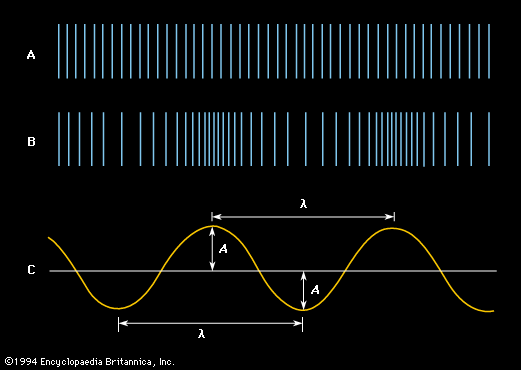
Frequency and Amplitude are the ingredients for any delcious soundwave you want to cook, and like everything some cooks are better than others. Anyone who has tried to create music before can tell you that. A wave is built up with many parts. First we want to look at a period of the wave. A period is the time it takes for a wave to make one complete cycle. From peak to peak so to speak. Encyclopedi britianica has an excellent graphical representation of this.

Figure 1: Graphic representations of a sound wave.
(A) Air at equilibrium, in the absence of a sound wave;
(B) compressions and rarefactions that constitute a sound wave;
(C) transverse representation of the wave, showing amplitude (A) and wavelength (λ).
As you can from the figure, the wavelength (λ) is the same as the period. This is very important because determining the frequency is dependant upon this. The freqency is the equal to the inverse of the period as seen in equation 1
This eqation will determine the frequency of the soundwave and thus the "note" at which the sound will resonate. Music relies upon the use of frequency because the differing notes that make up a scale can be related to different frequencies.
Another important aspect of the soundwave is the amplitude. the amplituded as seen as (A) in figure 1 above is what determines how loud the soundwave will be. Music uses an aspect called dynamics which is what helps bring out the emotional aspect of the music. A dramatic part of a sonata will be played loud and vigorously which means the amlitudes are high. A softer or quiter portion of the song will have low amplitudes. Now that we know two important aspects of creating a soundwave, how do instruments apply these physics and produce music?
Back to index